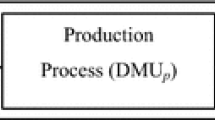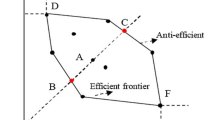Abstract
In the last decade, ranking units in data envelopment analysis (DEA) has become the interests of many DEA researchers and a variety of models were developed to rank units with multiple inputs and multiple outputs. These performance factors (inputs and outputs) are classified into two groups: desirable and undesirable. Obviously, undesirable factors in production process should be reduced to improve the performance. Also, some of these data may be known only in terms of ordinal relations. While the models developed in the past are interesting and meaningful, they didn’t consider both undesirable and ordinal factors at the same time. In this research, we develop an evaluating model and a ranking model to overcome some deficiencies in the earlier models. This paper incorporates undesirable and ordinal data in DEA and discusses the efficiency evaluation and ranking of decision making units (DMUs) with undesirable and ordinal data. For this purpose, we transform the ordinal data into definite data, and then we consider each undesirable input and output as desirable output and input, respectively. Finally, an application that shows the capability of the proposed method is illustrated.
Similar content being viewed by others
Explore related subjects
Discover the latest articles, news and stories from top researchers in related subjects.References
A. Charnes, W. W. Cooper, E. Rhodes. Measuring the efficiency of decision making units. European Journal of Operational Research, vol. 2, no. 6, pp. 429–444, 1978.
P. Andersen, N. C. Petersen. A procedure for ranking efficient units in data envelopment analysis. Management Science, vol. 39, no. 10, pp. 1261–1264, 1993.
S. Mehrabian, M. R. Alirezaee, G. R. Jahanshahloo. A complete efficiency ranking of decision making units in data envelopment analysis. Computational Optimization and Applications, vol. 14, no. 2, pp. 261–266, 1999.
T. R. Sexton, R. H. Silkman, A. J. Hogan. Data envelopment analysis: Critique and extensions. Measuring Efficiency: An Assessment of Data Envelopment Analysis, R. H. Silkman Ed., San Francisco, USA: Jossey-Bass, pp. 73–105, 1986.
N. Adler, L. Friedman, Z. Sinuany-Stern. Review of ranking methods in data envelopment analysis context. European Journal of Operational Research, vol. 140, no. 2, pp. 249–265, 2002.
G. R. Jahanshahloo, F. H. Lotfi, N. Shoja, G. Tohidi, S. Razavyan. Ranking using l 1-norm in data envelopment analysis. Applied Mathematics and Computation, vol. 153, no. 1, pp. 215–224, 2004.
G. R. Jahanshahloo, H. V. Junior, F. H. Lotfi, D. Akbarian. A new DEA ranking system based on changing the reference set. European Journal of Operational Research, vol. 181, no. 1, pp. 331–337, 2007.
S. Li, G. R. Jahanshahloo, M. Khodabakhshi. A superefficiency model for ranking efficient units in data envelopment analysis. Applied Mathematics and Computation, vol. 184, no. 2, pp. 638–648, 2007.
M. Izadikhah. Ranking units with interval data based on efficient and inefficient frontiers. Mathematics Scientific Journal, vol. 3, no. 2, pp. 49–57, 2007.
Y. M. Wang, Y. Luo, L. Liang. Ranking decision making units by imposing a minimum weight restriction in the data envelopment analysis. Journal of Computational and Applied Mathematics, vol. 223, no. 1, pp. 469–484, 2009.
F. Liu, H. H. Peng. Ranking of units on the DEA frontier with common weights. Computers and Operations Research, vol. 35, no. 5, pp. 1624–1637, 2008.
G. R. Jahanshahloo, F. H. Lotfi, M. Khanmohammadi, M. Kazemimanesh, V. Rezaie. Ranking of units by positive ideal DMU with common weights. Expert Systems with Applications, vol. 37, no. 12, pp. 7483–7488, 2010.
Y. M. Wang, Y. Luo, Y. X. Lan. Common weights for fully ranking decision making units by regression analysis. Expert Systems with Applications, vol. 38, no. 8, pp. 9122–9128, 2011.
G. X. Chen, M. Deng. A cross-dependence based ranking system for efficient and inefficient units in DEA. Expert Systems with Applications, vol. 38, no. 8, pp. 9648–9655, 2011.
F. R. Balf, H. Z. Rezai, G. R. Jahanshahloo, F. H. Lotfi. Ranking efficient DMUs using the Tchebycheff norm. Applied Mathematical Modelling, vol. 36, no. 1, pp. 46–56, 2012.
F. H. Lotfi, R. Fallahnejad, N. Navidi. Ranking efficient units in DEA by using TOPSIS method. Applied Mathematical Sciences, vol. 5, no. 17, pp. 805–815, 2011.
G. R. Jahanshahloo, F. H. Lotfi, M. Sanei, M. F. Jelodar. Review of ranking models in data envelopment analysis. Applied Mathematical Sciences, vol. 2, no. 29, pp. 1431–1448, 2008.
T. C. Koopmans. Analysis of production as an efficient combination of activities. Activity Analysis of Production and Allocation, vol. 36, no. 13, pp. 33–97, 1951.
P. Smith. Data envelopment analysis applied to financial statements. Omega, vol. 18, no. 2, pp. 131–138, 1990.
R. Färe, S. Grosskopf, C. A. K. Lovell, C. Pasurka. Multilateral productivity comparisons when some outputs are undesirable: A non-parametric approach. The Review of Economics and Statistics, vol. 71, no. 1, pp. 90–98, 1989.
R. Färe, S. Grosskopf, C. A. K. Lovell, S. Yaisawarang. Derivation of shadow prices for undesirable outputs: A distance function approach. The Review of Economics and Statistics, vol. 75, no. 2, pp. 374–380, 1993.
H. Scheel. Undesirable outputs in efficiency valuations. European Journal of Operational Research, vol. 132, no. 2, pp. 400–410, 2001.
L. M. Seiford, J. Zhu. Modeling undesirable factors in efficiency evaluation. European Journal of Operational Research, vol. 142, no. 1, pp. 16–20, 2002.
R. Färe, S. Grosskopf. Modeling undesirable factors in efficiency evaluation: Comment. European Journal of Operational Research, vol. 157, no. 1, pp. 242–245, 2004.
W. B. Liu, W. Meng, X. X. Li, D. Q. Zhang. DEA models with undesirable inputs and outputs. Annals of Operations Research, vol. 173, no. 1, pp. 177–194, 2010.
H. Xue, X. Li, H. X. Ma. Random fuzzy chance-constrained programming based on adaptive chaos quantum honey bee algorithm and robustness analysis. International Journal of Automation and Computing, vol. 7, no. 1, pp. 115–122, 2010.
X. Y. Luo, Z. H. Zhu, X. P. Guan. Adaptive fuzzy dynamic surface control for uncertain nonlinear systems. International Journal of Automation and Computing, vol.6, no. 4, pp. 385–390, 2009.
A. Charnes, W. W. Cooper, A. Y. Lewin, L. M. Seiford. Data Envelopment Analysis: Theory, Methodology and Applications, Norwell, USA: Kluwer Academic Publishers, 1994.
W. W. Cooper, K. S. Park, G. Yu. IDEA and AR-IDE: Model for dealing with imprecise data in DEA. Management Science, vol. 45, no. 4, pp. 597–607, 1999.
W. D. Cook, M. Kress, L. Seiford. On the use of ordinal data in data envelopment analysis. Journal of the Operational Research Society, vol. 44, no. 2, pp. 133–140, 1993.
W. D. Cook, M. Kress. A multiple criteria decision model with ordinal preference data. European Journal of Operational Research, vol. 54, no 2, pp. 191–198, 1991.
W. D. Cook, J. Doyle, R. Green, M. Kress. Multiple criteria modeling and ordinal data. European Journal of Operational Research, vol. 98, no. 3, pp. 602–609, 1997.
J. Zhu. Efficiency evaluation with strong ordinal input and output measures. European Journal of Operational Research, vol. 146, no. 3, pp. 477–485, 2003.
Author information
Authors and Affiliations
Corresponding author
Additional information
Zahra Aliakbarpoor received her B. Sc. degree in applied mathematics from the Payam-e-Noor University of Sary in 2002. She is now a graduate student of applied mathematics in Islamic Azad University of Arak, and working on her thesis.
Her research interest is data envelopment analysis in the presence of imprecise data.
Mohammad Izadikhah received his B. Sc. degree in applied mathematics from Amir Kabir University of Technology in 2001, and the M. Sc. degree in applied mathematics from Teacher Training University of Tehran in 2003, and the Ph.D. degree in applied mathematics from Islamic Azad University, Science and Research Branch of Tehran in 2007. Since 2007, he has been a faculty member at Islamic Azad University of Arak, and currently, he is an assistant professor in Department of Mathematics at Islamic Azad University of Arak. He has published about 30 refereed journal and conference papers.
His research interests include operations research, data envelopment analysis, multi-objective decision making and fuzzy theory, and operations research with imprecise data.
Rights and permissions
About this article
Cite this article
Aliakbarpoor, Z., Izadikhah, M. Evaluation and ranking DMUs in the presence of both undesirable and ordinal factors in data envelopment analysis. Int. J. Autom. Comput. 9, 609–615 (2012). https://doi.org/10.1007/s11633-012-0686-5
Received:
Revised:
Published:
Issue Date:
DOI: https://doi.org/10.1007/s11633-012-0686-5




